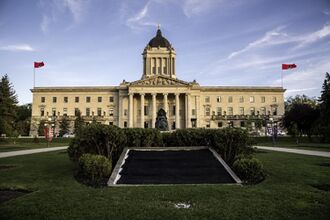The Imperial Palace (Rhodevus)
| The Imperial Palace | |
|---|---|
Palais Impérial de Rhodevus Kanónhsa Kho-hitn | |
 | |
| Former names | Presidential Palace, Royal Palace |
| General information | |
| Architectural style | neoclassical |
| Location | Kingstown, Rhodevus |
| Groundbreaking | 12 August 1747 |
| Completed | 2 October 1811 |
| Renovated | 1953-1954 1987-1989 |
| Client | Rhodeve Government |
| Owner | Monarch of Rhodevus, Kho-hitn |
| Technical details | |
| Floor count | 4 above ground, 3 below ground |
| Lifts/elevators | 5 |
The Imperial Palace is the center of Rhodeve royalty as well as the center of Rhodeve political life. The building is a part of the Imperial Palace Complex, which includes the Royal Federal Court, Senate and House of Commons. The main building, known as the Imperial Palace is the home of the monarch, but also includes a museum, orphanage and art gallery. Underneath the entire complex is a large system of tunnels, used to facilitate quick escape if the capital is attacked. Similarly, the historical archive and crypt is located underneath the palace complex, where the royal treasury and jewels are kept.
The Imperial Palace itself began construction in 1747. Its location was chosen to be right on top of Kho'hitn, but due to nationla backlash, especially among the native Rhodevans, the building was redesigned to incorporate the Soul Tree. The palace; known at the time as the Presidential Palace, was to be the home of the president, as well as the senate. The materials were carefully selected from around the empire to portray immense wealth and power. As such, the construction was often slowed due to war or slow travel times from the far reaches of the empire. The palace complex was finally completed in 1811.
After the fall of the republic and empire, the palace was rechristened the Royal Palace to be used as the home for the reigning monarch. It was finally renamed the Imperial Palace in 1909.
Inside, the Imperial Palace is filled with hundreds of pieces of artwork, stained glass, statues, paintings and monuments from around the world. Gold, marble, silver, bronze and other precious stones are inlaid into the foundations to convey power and beauty. The palace itself was designed with acoustics in mind, as there are multiple places where whispered conversations can be heard from across the hallway, or not at all depending on where it is spoken from.
A large-scale refurbishment of the Imperial Palace complex took place in 1953 until 1954 and then again in 1987 to 1989 to modernize the building as well as ensure it remains heavily fortified in case of attack or instrusion.
History
Planning and Initial Construction
Grounds and Name
Palace Buildings
The Imperial Palace Complex is comprised of 14 buildings in an octagonal shape, all situated on the shore of Lake Bart.